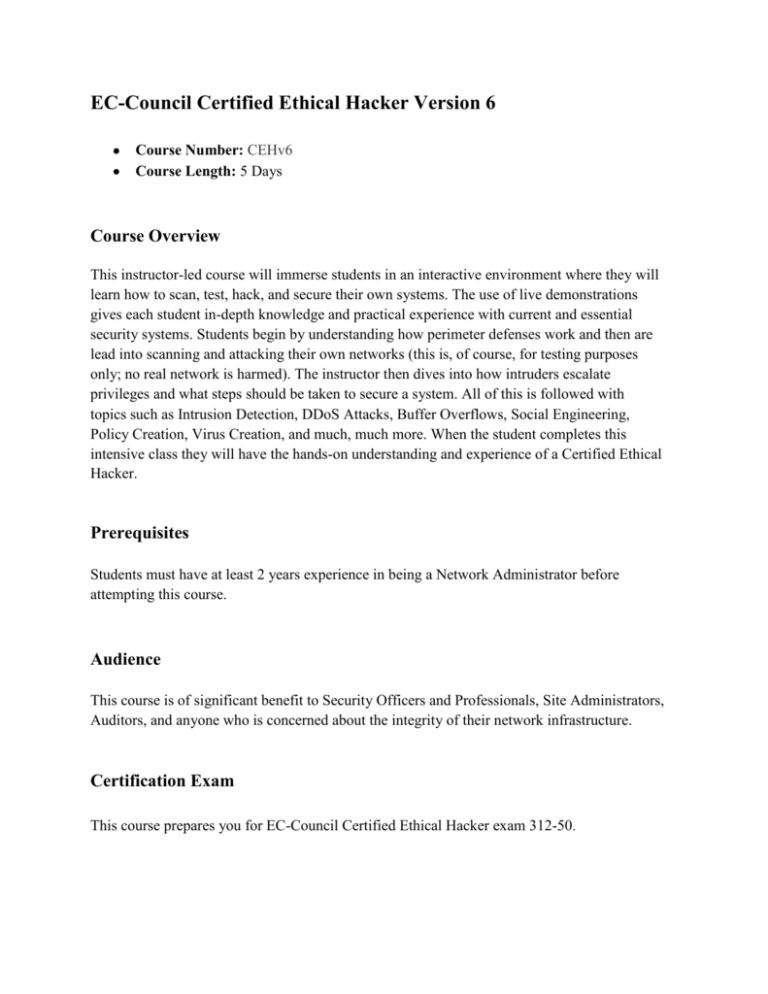Certified Ethical Hacker Version 6 (CEHv6)
advertisement

EC-Council Certified Ethical Hacker Version 6 Course Number: CEHv6 Course Length: 5 Days Course Overview This instructor-led course will immerse students in an interactive environment where they will learn how to scan, test, hack, and secure their own systems. The use of live demonstrations gives each student in-depth knowledge and practical experience with current and essential security systems. Students begin by understanding how perimeter defenses work and then are lead into scanning and attacking their own networks (this is, of course, for testing purposes only; no real network is harmed). The instructor then dives into how intruders escalate privileges and what steps should be taken to secure a system. All of this is followed with topics such as Intrusion Detection, DDoS Attacks, Buffer Overflows, Social Engineering, Policy Creation, Virus Creation, and much, much more. When the student completes this intensive class they will have the hands-on understanding and experience of a Certified Ethical Hacker. Prerequisites Students must have at least 2 years experience in being a Network Administrator before attempting this course. Audience This course is of significant benefit to Security Officers and Professionals, Site Administrators, Auditors, and anyone who is concerned about the integrity of their network infrastructure. Certification Exam This course prepares you for EC-Council Certified Ethical Hacker exam 312-50. Course Outline Course Introduction 4m Course Introduction Module 00 - Student Introduction 9m Student Introduction Self Study Modules EC-Council Certification Program Certified Ethical Hacker Track CEHv6 Exam Information Lab Sessions What does CEH teach you? Remember This! CEH Class Speed Live Hacking Website Student Introduction Review Module 01 - Penetration Testing 101 Penetration Testing 101 To Know more about Penetration Testing, Attend EC-Council's LPT Program Introduction to PT Hands-on: Module Overview - History of Hackers Categories of Security Assessments Vulnerability Assessment Limitations of Vulnerability Assessment Penetration Testing Types of Penetration Testing Risk Management Hands-on: CIO View Self Assessment Do-it-Yourself Testing Hands-on: Security focus website Outsourcing Penetration Testing Services Terms of Engagement Hands-on: NIST Methodology Project Scope Pentest Service Level Agreements Testing Points Hands-on: Zero-Day and Research Testing Locations Automated Testing Manual Testing Using DNS Domain Name and IP Address Information Enumerating Information about Hosts on Publicly-Available Networks Testing Network-Filtering Devices Enumerating Devices Denial of Service Emulation Penetration Testing Tools 1h 59m Evaluating Different Types of Pentest Tools Asset Audit Fault Trees and Attack Trees GAP Analysis Threats Threat Business Impact of Threat Internal Metrics Threat External Metrics Threat Calculating Relative Criticality Test Dependencies Other Tools Useful in Pen-Test Phases of Penetration Testing Pre-Attack Phase Best Practices Results that can be Expected Passive Reconnaissance Active Reconnaissance Attack Phase Activity: Perimeter Testing Activity: Web Application Testing - I Activity: Web Application Testing - II Activity: Web Application Testing - III Activity: Wireless Testing Activity: Acquiring Target Activity: Escalating Privileges Activity: Execute, Implant, and Retract Post-Attack Phase and Activities Penetration Testing Deliverables Templates Hands-on: BT4 VM Install 101 Hands-on: Virtual Box Penetration Testing Review Module 02 - Introduction to Ethical Hacking Introduction to Ethical Hacking Hands-on: VMware Basics Overview 01 Hands-on: VMware Basics Overview 02 Hands-on: Opening An Existing XP VMware System Hands-on: Opening VM Appliance Hands-on: Installing A New VM System Hands-on: Boot XP VM From Backtrack ISO Module Objective Module Flow Problem Definition - Why Security? Essential Terminologies Hands-on: Quantitive Threat Analysis Elements of Security Hands-on: Technology Evolution 2h 34m The Security, Functionality, and Ease of Use Triangle Case Study What Does a Malicious Hacker Do Effect on Business Phase 1 - Reconnaissance Reconnaissance Types Phase 2 - Scanning Hands-on: Port Scanning Phase 3 - Gaining Access Phase 4 - Maintaining Access Phase 5 - Covering Tracks Types of Hacker Attacks 1. Operating System Attacks Hands-on: OS Attack Security News: Default Installation 2. Application Level Attacks Hands-on: Application Attacks 3. Shrink Wrap Code Attacks 4. Misconfiguration Attacks Remember This Rule! Hacktivism Hacker Classes Ethical Hacker Classes What Do Ethical Hackers Do Hands-on: Ethical Hacking Research Can Hacking be Ethical How to Become an Ethical Hacker Skill Profile of an Ethical Hacker What is Vulnerability Research Why Hackers Need Vulnerability Research Hands-on: Vulnerability Research Resources Vulnerability Research Tools Hands-on: Milw0rm Progenic Websites How to Conduct Ethical Hacking Hands-on: Pen-Test Templates and Methodologies How Do They Go About It Approaches to Ethical Hacking Ethical Hacking Testing Ethical Hacking Deliverables Hands-on: Computer Crimes and Implications Computer Crimes and Implications What Happened Next Hands-on: Module Summary Tips Introduction to Ethical Hacking Review Module 03 – Footprinting Footprinting Module Objective Module Flow 1h 47m Revisiting Reconnaissance Defining Footprinting Why is Footprinting Necessary Areas and Information which Attackers Seek Information Gathering Information Gathering Methodology Unearthing Initial Information Hands-on: Sam Spade Finding a Company's URL Internal URL Extracting Archive of a Website Hands-on: Wayback Machine Google Search for Company's Info. People Search Satellite Picture of a Residence Footprinting Through Job Sites Passive Information Gathering Competitive Intelligence Gathering Why Do You Need Competitive Intelligence Competitive Intelligence Resource Hands-on: Competitive Intelligence Services Competitive Intelligence Tool: Web Investigator Reputica Dashboard MyReputation Public and Private Websites Footprinting Tools Whois Tools Hands-on: Wikto Hands-on: Whois Online And Backtrack Hands-on: CountryIP Hands-on: FireCat, Firefox Assessment Add Ons DNS Information Extraction Tools Tool: DNS Enumerator Hands-on: Nslookup Locating Network Range Hands-on: Networkblock And Traceroute Arin Traceroute Trace Route Analysis Hands-on: ICMP Traceroute Serversniff Hands-on: Visual IPtrace Tool: Maltego Hands-on: Kartoo / Maltego Hands-on: Maltego Info Gathering Layer Four Traceroute E-mail Spiders Hands-on: Email Spider Tool: 1st E-mail Address Spider Hands-on: Core Impact Email Info Gathering Locating Network Activity Tool: GEOSpider Tool: Geowhere Hands-on: Google Earth, News Groups, Facebook Search Engines Kartoo Search Engine Dogpile (Meta Search Engine) robots.txt How to Fake Websites Faking Websites using Man-in-the-Middle Phishing Kit Steps to Perform Footprinting What Happened Next Hands-on: New Tool Bonus: Netifera Hands-on: New Tool Bonus: SEAT Search-Engine-Assessment-Tool Hands-on: Module Summary Tips Footprinting Review Module 04 - Google Hacking Google Hacking Module Flow What is Google Hacking What a Hacker Can do With Vulnerable Site Anonymity with Caches Hands-on: Google Hacking Overview Using Google as a Proxy Server Hands-on: Google As A Proxy Server Directory Listings Locating Directory Listings Hands-on: Google Directory Listings Hands-on: Google: Finding Specific Files Hands-on: Splunk Server Versioning Going Out on a Limb: Traversal Techniques Directory Traversal Incremental Substitution Extension Walking Google Advanced Operators Pre-Assessment intranet | help.desk Locating Exploits and Finding Targets Locating Public Exploit Sites Locating Vulnerable Targets "Powered by" Tags Are Common Query Fodder for Finding Web Applications Vulnerable Web Application Examples Locating Targets via CGI Scanning Web Server Software Error Messages Hands-on: Default Page Search: Tsweb 1h 5m Google Hacking Tools Hands-on: Metagoofil Search Hands-on: New Tool: SEAT Google Hacking Database (GHDB) SiteDigger Tool Gooscan Goolink Scanner Hands-on: Google Hack HoneyPot Hands-on: Goolag Wikto Automated Google Hack Honeypot Hands-on: Summary Google, Locating Live Cams Google Hacking Review Module 05 – Scanning Scanning Module Objective Scanning - Definition Types of Scanning Objectives of Scanning CEH Scanning Methodology Checking for Live Systems Checking for Live Systems - ICMP Scanning Hands-on: NMAP is the Host IP Hands-on: NMAP Zenmap GUI Console Hands-on: Angry IP Scanner Firewalk Tool Hands-on: Tips and Installing ScanRand in Backtrack Checking for Open Ports Hands-on: Tip Video: TCPIP for Sec Pros Three Way Handshake Hands-on: techtionary.com Port Numbers Hands-on: techtionary.com TCP Handshake and Ack TCP Communication Flags Nmap Nmap: Scan Methods Hands-on: Basic Scan Techniques Using NMAP Hands-on: Launching a Scan from CentralOps Webserver Hands-on: NMAP Verbose NMAP Output Format Hands-on: LEO Tracking Your Results Hands-on: Tips and Saving Your Results with LEO Hands-on: NMAP Output for Reports Hands-on: Port Scan and Exploitation Using Core Impact HPING2 Hands-on: HPING Basics ICMP Echo Scanning/List Scan 3h 56m TCP Connect / Full Open Scan SYN/FIN Scanning Using IP Fragments UDP Scanning IPSecScan Hands-on: IPSec Scanner FloppyScan ike-scan Hands-on: ike-scan LANView Hands-on: Port Scanning with Look at LAN Hands-on: Unicorn Scanning to MySQL Colasoft MAC Scanner War Dialer Technique Why War Dialing? War Dialing Countermeasures SandTrap Tool Banner Grabbing OS Fingerprinting Active Stack Fingerprinting Hands-on: OS Fingerprinting Tool Examples Hands-on: NMAP OS Fingerprinting Hands-on: Scanning with AutoScan Passive Fingerprinting Active Banner Grabbing Using Telnet Hands-on: Banner Grabbing with Telnet Hands-on: HTTPrint Fingerprinting Webservers Tools for Active Stack Fingerprinting Disabling or Changing Banner IIS Lockdown Tool Hands-on: Nessus Client Vulnerability Scanning Hands-on: Vulnerability Research Hands-on: Nessus3 For Windows Qualys Web-based Scanner SAINT Nessus Hands-on: Installing Nessus in BackTrack Draw Network Diagrams of Vulnerable Hosts FriendlyPinger Hands-on: Spiceworks Network Mapping and Inventory Hands-on: Tip: Research Advice LANsurveyor Preparing Proxies Proxy Servers Use of Proxies for Attack SocksChain How Does MultiProxy Work TOR Proxy Chaining Software Hands-on: Janus TOR Proxy Anonymizers Surfing Anonymously Psiphon Bloggers Write Text Backwards to Bypass Web Filters in China Hands-on: Jap Anonymous Web Surfing Hands-on: SecureStar SSH Tunnel Software Google Cookies Hands-on: HTTP Tunnels and Port Forwarding Hands-on: SSH SSL Tunnels and Port Forwarding Hands-on: SecureStar SSH Spoofing IP Address Detecting IP Spoofing Despoof Tool Scanning Countermeasures What Happened Next? Scanning Review Module 06 – Enumeration Enumeration Module Flow Hands-on: Reconnaissance Refresher Overview of System Hacking Cycle What is Enumeration Techniques for Enumeration Netbios Null Sessions So What's the Big Deal Tool: DumpSec Hands-on: Null Session Tools NetBIOS Enumeration Using Netview Hands-on: SMB NAT Dictionary Attack Hands-on: Enumeration Banners Null Session Countermeasures Hands-on: Countermeasures PS Tools SNMP Enumeration Management Information Base SNMPutil Example Hands-on: SNMP Enumeration with BT Tool: Solarwinds UNIX Enumeration SNMP UNIX Enumeration SNMP Enumeration Countermeasures LDAP Enumeration Jxplorer NTP Enumeration SMTP Enumeration Hands-on: Injecting The Abel Service Web Enumeration 1h 6m Asnumber Lynx Windows Active Directory Attack Tool How To Enumerate Web Application Directories in IIS Using Directory Services Enumerate Systems Using Default Passwords Terminal Service Agent Tool: TXDNS Hands-on: NSLookup DNS Zone Transfer What Happened Next Enumeration Review Module 07 - System Hacking System Hacking Module Flow Hands-on: AFX Rootkit CEH Hacking Cycle 01 Password Types Types of Password Attacks Hands-on: Monitoring User Login Passive Online Attack: Wire Sniffing Passive Online Attack: Man-in-the-Middle and Replay Attacks Hands-on: SSL MITM Active Online Attack: Password Guessing Offline Attacks Hands-on: Cain and Abel Dictionary Attack Offline Attack: Brute-force Attack Offline Attack: Pre-Computed Hashes Hands-on: Local Password Reset Hands-on: Backtrack: Local XP Password Attack Syllable Attack/Rule-based Attack/Hybrid Attack Distributed Network Attack Hands-on: Rainbow Table Cracking Non-Technical Attacks PDF Password Cracker Hands-on: Removing A PDF Password Password Mitigation Permanent Account Lockout - Employee Privilege Abuse Administrator Password Guessing Manual Password Cracking Algorithm Automatic Password Cracking Algorithm Microsoft Authentication LM, NTLMv1, and NTLMv2 NTLM and LM Authentication on the Wire Kerberos Authentication What is LAN Manager Hash Salting Hands-on: TS Grinder Hands-on: Cracking Your Local XP 64bit Password with Ophcrack 2h 43m Password Cracking Countermeasures Do Not Store LAN Manager Hash in SAM Database LM Hash Backward Compatibility Escalating Privileges Privilege Escalation Hands-on: Privilege Escalation Executing Applications Actual Spy Hands-on: Hardware Keystroke Loggers Wiretap Professional Keylogger Countermeasures Anti-Keylogger Hiding Files 01 CEH Hacking Cycle 02 Hiding Files 02 Rootkits Why Rootkits Rootkits in Linux Detecting Rootkits Steps for Detecting Rootkits Sony Rootkit Case Study Hands-on: Dreampak PL Rootkit Rootkit Countermeasures Creating Alternate Data Streams Hands-on: Alternate Data Streams NTFS Streams Countermeasures Hacking Tool: USB Dumper Steganography Hands-on: Steganography Least Significant Bit Insertion in Image Files Steganography Tools Steganography Detection Steganalysis Steganalysis Methods/Attacks on Steganography Steganalysis Tools Stegdetect Covering Tracks Hands-on: Darins Boot and Nuke Disabling Auditing Clearing the Event Log What Happened Next System Hacking Review Module 08 - Trojans and Backdoors Trojans and Backdoors Introduction What is a Trojan Overt and Covert Channels Working of Trojans 52m Different Types of Trojans What Do Trojan Creators Look For Different Ways a Trojan Can Get into a System Indications of a Trojan Attack Ports Used by Trojans How to Determine which Ports are "Listening" Hands-on: Determining What Ports are Listening Wrappers Hands-on: Wrapping Tool: EliteWrap Hands-on: IronGeek Splice RemoteByMail HTTP Trojans ICMP Tunneling Trojan: Netcat Hands-on: Using Netcat for Basic Exploits Hands-on: Netcat 101 Hands-on: Netcat Banner Dump Hacking Tools Trojan Detecting Tools How to Detect Trojans Hands-on: Malware Detection Delete Suspicious Device Drivers Check for Running Processes: What's on My Computer Super System Helper Tool Tool: MSConfig Hands-on: Keeping Up-To-Date for Malware Anti-Trojan Software TrojanHunter Backdoor Countermeasures Tool: Tripwire Hands-on: System File Verification System File Verification How to Avoid a Trojan Infection What happened next Trojans and Backdoors Review Module 09 - Viruses and Worms Viruses and Worms Introduction to Virus Virus History Characteristics of a Virus Working of Virus Why People Create Computer Viruses Symptoms of Virus-Like Attack Virus Hoaxes Worms How is a Worm different from a Virus Indications of a Virus Attack Hardware Threats 50m Software Threats Stages of Virus Life Types of Viruses Virus Classification How does a Virus Infect Storage Patterns of a Virus System Sector Viruses Stealth Virus Bootable CD-ROM Virus Self-Modification Encryption with a Variable Key Polymorphic Code Metamorphic Virus Cavity Virus Sparse Infector Virus Companion Virus File Extension Virus Famous Viruses and Worms Famous Viruses/Worms: I Love You Virus Zombies and DoS Spread of Slammer Worm - 30 min Latest Viruses Disk Killer Writing Virus Programs Writing a Simple Virus Program Virus Construction Kits Examples of Virus Construction Kits Hands-on: Stealth Toolv2: Hide Viruses and Malware Virus Detection Methods Virus Incident Response What is Sheep Dip Virus Analysis - IDA Pro Tool Hands-on: Beast Remote Trojan Prevention is Better than Cure Anti-Virus Software Viruses and Worms Review Module 10 – Sniffers Sniffers Definition: Sniffing Protocols Vulnerable to Sniffing Types of Sniffing Passive Sniffing Active Sniffing Hands-on: Engard Packet Builder What is Address Resolution Protocol (ARP) Hands-on: Sniffers and ARP Tool: Network View - Scans the Network for Devices Hands-on: Basic Sniffers 1h 4m Hands-on: TCP Dump Wiretap RF Transmitter Wiretaps Infinity Transmitter Slave Parallel Wiretaps Switched Port Analyzer (SPAN) Lawful Intercept Benefits of Lawful Intercept Network Components Used for Lawful Intercept ARP Spoofing Attack How Does ARP Spoofing Work Hands-on: ARP Poisoning With Cain Hands-on: Cain DNS Spoofing Hands-on: SSL MITM Hands-on: Cain VoIP Mac Duplicating Mac Duplicating Attack ARP Spoofing Tools MAC Flooding Tools Threats of ARP Poisoning Hands-on: Engage Packet Builder IP-based Sniffing Linux Sniffing Tools DNS Poisoning Techniques 1. Intranet DNS Spoofing (Local Network) 2. Internet DNS Spoofing (Remote Network) 3. Proxy Server DNS Poisoning 4. DNS Cache Poisoning Interactive TCP Relay Raw Sniffing Tools Features of Raw Sniffing Tools Detecting Sniffing How to Detect Sniffing Countermeasures Hands-on: SecureNNTP Tunnel Sniffers Review Module 11 - Social Engineering Social Engineering There is No Patch to Human Stupidity What is Social Engineering Human Weakness "Rebecca" and "Jessica" Office Workers Types of Social Engineering Human-Based Social Engineering Human-Based Social Engineering: Eavesdropping Human-Based Social Engineering: Shoulder Surfing Human-Based Social Engineering: Dumpster Diving 1h 3m Dumpster Diving Example Human-Based Social Engineering (cont'd) Movies to Watch for Reverse Engineering Examples: The Italian Job and Catch Me If You Can Computer-Based Social Engineering Hands-on: Hotmail Social Engineering Insider Attack Disgruntled Employee Preventing Insider Threat Common Targets of Social Engineering Social Engineering Threats and Defenses Online Threats Telephone-Based Threats Personal Approaches Defenses Against Social Engineering Threats Factors that make Companies Vulnerable to Attacks Why is Social Engineering Effective Warning Signs of an Attack Tool: Netcraft Anti-Phishing Toolbar Phases in a Social Engineering Attack Behavoirs Vulnerable to Attacks Impact on the Organization Countermeasures Policies and Procedures Impersonating on Facebook Identity Theft Hands-on: Social Engineering Example Social Engineering Review Module 12 – Phishing Phishing Introduction Reasons for Successful Phishing Phishing Methods Process of Phishing Types of Phishing Attacks Man-in-the-Middle Attacks URL Obfuscation Attacks Cross-site Scripting Attacks Hidden Attacks Client-side Vulnerabilities Deceptive Phishing Malware-Based Phishing DNS-Based Phishing Content-Injection Phishing Search Engine Phishing Anti-Phishing Hands-on: Phishing Video Phishing Review 21m Module 13 - Hacking Email Accounts 11m Hacking Email Accounts Introduction Ways for Getting Email Account Information Stealing Cookies Social Engineering Password Phishing Fraudulent e-mail Messages Vulnerabilities Vulnerabilities: Web Email Email Hacking Tools Securing Email Accounts Creating Strong Passwords Sign-in Seal Alternate Email Address Keep Me Signed In/Remember Me Hands-on: Hacking Email Accounts Hacking Email Accounts Review Module 14 - Denial of Service Denial of Service Terminologies Goal of DoS Impact and the Modes of Attack Types of Attacks DoS Attack Classification Smurf Attack Buffer Overflow Attack Ping of Death Attack Hands-on: Ping of Death and Nemesy Teardrop Attack SYN Attack SYN Flooding DoS Attack Tools Bot (Derived from the Word RoBOT) Botnets Uses of Botnets Types of Bots How Do They Infect? Analysis Of Agabot DDOS Unstoppable DDoS Attack Taxonomy Reflective DNS Attacks DDoS Tools How to Conduct a DDoS Attack Reflection of the Exploit Countermeasures for Reflected DoS Taxonomy of DDoS Countermeasures Preventing Secondary Victims Detect and Neutralize Handlers Mitigate or Stop the Effects of DDoS Attacks 38m Post-attack Forensics Denial of Service Review Module 15 - Session Hijacking 32m Session Hijacking What is Session Hijacking Understanding Session Hijacking Spoofing vs. Hijacking Steps in Session Hijacking Types of Session Hijacking Session Hijacking Levels Network Level Hijacking The 3-Way Handshake Sequence Numbers Sequence Number Prediction TCP/IP Hijacking IP Spoofing: Source Routed Packets RST Hijacking Blind Hijacking Man in the Middle: Packet Sniffer UDP Hijacking Application Level Hijacking Session Hijacking Tools Programs that Perform Session Hijacking Dangers Posed by Hijacking Countermeasures Protecting against Session Hijacking Countermeasure: IP Security What Happened Next Hands-on: Tsight Session Hijack Session Hijacking Review Module 16 - Hacking Web Servers Hacking Web Servers How are Web Servers Compromised Web Server Defacement How are Web Servers Defaced Attacks Against IIS IIS 7 Components IIS Directory Traversal (Unicode) Attack ServerMask ip100 Unicode Hands-on: Input Injection Attack Hands-on: Viewing Website with Telnet Core Impact Professional 101 Core Impact Professional Networking Attack Vector Client Side Application Testing Web Application Testing 2h 39m Core Impact Professional 101 Review Patch Management Hotfixes and Patches What is Patch Management Vulnerability Scanners Hands-on: Spider Countermeasures File System Traversal Countermeasures Increasing Web Server Security Hacking Web Servers Review Module 17 - Web Application Vulnerabilities Web Application Vulnerabilities Web Application Setup Web Application Hacking Anatomy of an Attack Web Application Threats Cross-Site Scripting/XSS Flaws Countermeasures 01 SQL Injection Command Injection Flaws Countermeasures 02 Cookie/Session Poisoning Countermeasures 03 Parameter/Form Tampering Buffer Overflow Countermeasures 04 Directory Traversal/Forceful Browsing Countermeasures 05 Cryptographic Interception Cookie Snooping Authentication Hijacking Countermeasures 06 Log Tampering Error Message Interception Attack Obfuscation Platform Exploits DMZ Protocol Attacks Countermeasures 07 Security Management Exploits Web Services Attacks Zero-Day Attacks Network Access Attacks Hands-on: WebGoat Hands-on: NTO Spider Web Application Vulnerabilities Review 1h 42m Module 18 - Web-Based Password Cracking Techniques 41m Web-Based Password Cracking Techniques Authentication Authentication - Definition Authentication Mechanisms HTTP Authentication Basic Authentication Digest Authentication Integrated Windows (NTLM) Authentication Negotiate Authentication Certificate-based Authentication Forms-based Authentication RSA SecurID Token Biometrics Authentication Types of Biometrics Authentication Fingerprint-based Identification Hand Geometry-based Identification Retina Scanning Afghan Woman Recognized After 17 Years Face Recognition Face Code: WebCam Based Biometrics Authentication System Password Cracking How to Select a Good Password Things to Avoid in Passwords Changing Your Password Windows XP: Remove Saved Passwords What is a Password Cracker Modus Operandi of an Attacker Using Password Cracker How does a Password Cracker Work Attacks - Classification Password Guessing Query String Cookies Dictionary Maker Password Cracking Tools Security Tools Password Administrator Countermeasures Hands-on: Cracking Passwords with Xhydra Web-Based Password Cracking Techniques Review Module 19 - SQL Injection SQL Injection What is SQL Injection Exploiting Web Applications SQL Injection Steps What Should You Look For What If It Doesn't Take Input OLE DB Errors SQL Injection Techniques 38m How to Test for SQL Injection Vulnerability How Does it Work BadLogin.aspx.cs Executing Operating System Commands Getting Output of SQL Query Getting Data from the Database Using ODBC Error Message SQL Injection in Oracle SQL Injection in MySql Database Attack Against SQL Servers SQL Server Resolution Service (SSRS) Osql L-Probing SQL Injection Tools SQL Injection Automated Tools Blind SQL Injection Blind SQL Injection: Countermeasures SQL Injection Countermeasures Preventing SQL Injection Attacks Hands-on: SQL Injection Hands-on: SQL with Lee Lawson SQL Injection Review Module 20 - Hacking Wireless Networks Hacking Wireless Networks Introduction to Wireless Networking Wired Network vs. Wireless Network Effects of Wireless Attacks on Business Types of Wireless Network Hands-on: Techtionary Website Advantages and Disadvantages of a Wireless Network Wireless Standards Wireless Standard: 802.11a Wireless Standard: 802.11b - "WiFi" Wireless Standard: 802.11g Wireless Standard: 802.11i Wireless Standard: 802.11n Related Technology and Carrier Networks Antennas Hands-on: Resources for Antennas Cantenna Wireless Access Points Hands-on: Linksys AP Config SSID Hands-on: Asus WL530G Config SSID SSID Beacon Frames Is the SSID a Secret Setting up a WLAN Authentication and Association Authentication Modes Hands-on: Authentication Settings 2h 46m The 802.1X Authentication Process Wired Equivalent Privacy (WEP) Hands-on: WEP Setup Security WEP Issues What is WPA WPA WPA Vulnerabilities WEP, WPA, and WPA2 WPA2 Wi-Fi Protected Access 2 Attacks and Hacking Tools Terminologies Authentication and (Dis)Association Attacks WEP Attack Cracking WEP Hands-on: Hacking WEP Encryption Weak Keys (a.k.a. Weak IVs) Problems with WEP's Key Stream and Reuse Automated WEP Crackers Attacking WPA Encrypted Networks Hands-on: Cracking WPA with Cain and Abel Evil Twin: Attack Rogue Access Points Hands-on: Tool: NetStumbler Cloaked Access Point Temporal Key Integrity Protocol (TKIP) Hands-on: WEP Cracking with Cain and Abel Hands-on: MAC SSID Security Phone Jammers Phone Jammer: Mobile Blocker 2.4Ghz Wi-Fi & Wireless Camera Jammer 3 Watt Digital Cell Phone Jammer 3 Watt Quad Band Digital Cellular Mobile Phone Jammer Detecting a Wireless Network Scanning Tools Hands-on: Tool: Kismet in Linux Hands-on: Alternate War Driving Sniffing Tools Hands-on: Wireless Sniffing with Omni-Peek Hands-on: Airmagnet Laptop Analyzer Hacking Wireless Networks 02 Step 1: Find Networks to Attack Step 2: Choose the Networks to Attack Step 3: Analyzing the Network Step 4: Cracking the WEP Key Step 5: Sniffing the Network Wireless Security Radius: Used as Additional Layer in Security Securing Wireless Networks WLAN Security: Passphrase Don'ts in Wireless Security Wireless Security Tools Google Secure Access Hands-on: Tool: Inssider Hands-on: Tool: WiSpy Spectrum Analyzer Hands-on: Tool: Jasager Fon Router Hands-on: Tips and Resources Hacking Wireless Networks Review Module 21 - Physical Security Physical Security Security Facts Understanding Physical Security Physical Security 02 What Is the Need for Physical Security Who Is Accountable for Physical Security Factors Affecting Physical Security Physical Security Checklist 01 Physical Security Checklist: Company Surroundings Gates Security Guards Physical Security Checklist: Premises CCTV Cameras Physical Security Checklist: Reception Physical Security Checklist: Server Physical Security Checklist: Workstation Area Physical Security Checklist: Wireless Access Points Physical Security Checklist: Other Equipment Physical Security Checklist: Access Control Physical Security Checklist: Biometric Devices Biometric Identification Techniques Authentication Mechanisms Authentication Mechanisms Challenges: Biometrics Faking Fingerprints Physical Security Checklist 02 Smart Cards Security Token Computer Equipment Maintenance Wiretapping Remote Access Locks Lock Picking Lock Picking Tools Information Security EPS (Electronic Physical Security) Wireless Security Laptop Theft Statistics for 2007 Statistics for Stolen and Recovered Laptops Laptop Theft 48m Laptop Security Tools Laptop Tracker - Xtool Computer Tracker Laptop Security Countermeasures Mantrap TEMPEST Challenges in Ensuring Physical Security Spyware Technologies Physical Security: Lock Down USB Ports Hands-on: Bump Key Animation Physical Security Review Module 22 - Linux Hacking Linux Hacking Why Linux Linux - Basics Linux Live CD-ROMs Basic Commands of Linux: Files & Directories Linux Networking Commands Directories in Linux Installing, Configuring, and Compiling Linux Kernel How to Install a Kernel Patch Compiling Programs in Linux Make Files Make Install Command Linux Vulnerabilities Chrooting Why is Linux Hacked How to Apply Patches to Vulnerable Programs Port Scan Detection Tools Password Cracking in Linux: Xcrack Firewall in Linux: IPTables Basic Linux Operating System Defense Linux Loadable Kernel Modules Hacking Tool: Linux Rootkits Rootkit: Countermeasures Linux Tools: Application Security Advanced Intrusion Detection Environment (AIDE) Linux Tools: Encryption Steps for Hardening Linux Hands-on: BackTrack2 KDE or FluxBox Desktops Hands-on: BT2 Shell Basics Hands-on: BT2 Password Files Hands-on: BT2 User Account Changes Hands-on: BT2 Network Config Hands-on: BT2 Mounting with VMWare Hands-on: BT2 Compiling from Source Code Hands-on: BT2 Overview of Services Linux Hacking Review 1h 24m Module 23 - Evading IDS, Firewalls and Honeypots Evading IDS, Firewalls and Honeypots Introduction to Intrusion Detection Systems Terminologies Intrusion Detection System Intrusion Detection System (IDS) IDS Placement Ways to Detect an Intrusion Types of Intrusion Detection Systems System Integrity Verifiers (SIV) Tripwire (www.tripwire.com) Cisco Security Agent (CSA) True/False, Positive/Negative Signature Analysis General Indications of Intrusion System Indications General Indications of Intrusion File System Indications General Indications of Intrusion Network Indications Intrusion Detection Tools Snort Hands-on: Snort IDS Testing Scanning Tools Running Snort on Windows 2003 Snort Rules SnortSam Steps to Perform After an IDS Detects an Attack Evading IDS Systems Ways to Evade IDS Tools to Evade IDS Hands-on: Secure Tunnels and Anonymizer Techniques Firewall What is a Firewall What does a Firewall do Packet Filtering What can't a Firewall do How does a Firewall Work Hands-on: Video: Warriors of the Net Hardware Firewall Types of Firewalls Packet Filtering Firewall Circuit-Level Gateway Application-Level Firewall Stateful Multilayer Inspection Firewall Firewall Identification Firewalking Banner Grabbing Breaching Firewalls Placing Backdoors Through Firewalls Honeypot What is a Honeypot The Honeynet Project Types of Honeypots 1h 17m Advantages and Disadvantages of a Honeypot Where to Place a Honeypot Physical and Virtual Honeypots Tools to Detect Honeypots What to do When Hacked Evading IDS, Firewalls and Honeypots Review Module 24 - Buffer Overflows 1h 8m Buffer Overflows Why are Programs/Applications Vulnerable Buffer Overflows 02 Reasons for Buffer Overflow Attacks Knowledge Required to Program Buffer Overflow Exploits Understanding Stacks Hands-on: Stack Function Hands-on: Saint Exploit of Windows XP Understanding Heaps Types of Buffer Overflows: Stack-Based Buffer Overflow Stack Based Buffer Overflows Types of Buffer Overflows: Heap-Based Buffer Overflow Heap-Based Buffer Overflow Understanding Assembly Language Shellcode How to Detect Buffer Overflows in a Program Hands-on: Fuzzing for Weaknesses Attacking a Real Program Hands-on: Metasploit Introduction Hands-on: Metasploit 101 Hands-on: Metasploit Interactive NOPS How to Mutate a Buffer Overflow Exploit Once the Stack is Smashed… Defense Against Buffer Overflows Tool to Defend Buffer Overflow: Return Address Defender (RAD) Tool to Defend Buffer Overflow: StackGuard Valgrind Insure++ Hands-on: Compiling Exploits from Source Code Buffer Overflows Review Module 25 – Cryptography Cryptography Cryptography 02 Classical Cryptographic Techniques Hands-on: Cryptanalysis with Cryptool Encryption Decryption Cryptographic Algorithms 1h 15m Hands-on: Hashes to Verify Downloads RSA (Rivest Shamir Adleman) RSA Attacks RSA Challenge Data Encryption Standard (DES) DES Overview RC4, RC5, RC6, Blowfish Hands-on: RC4 with Cryptool RC5 Message Digest Functions One-way Bash Functions MD5 SHA (Secure Hash Algorithm) SSL (Secure Sockets Layer) What is SSH Hands-on: IPSEC Sessions Algorithms and Security Hands-on: Hardware Encryption Disk Encryption Government Access to Keys (GAK) Digital Signature Hands-on: Digital Signatures with Cryptool Components of a Digital Signature Method of Digital Signature Technology Digital Signature Applications Digital Signature Standard Digital Signature Algorithms: ECDSA, ElGamal Signature Scheme Challenges and Opportunities Digital Certificates Encryption Engine Code Breaking: Methodologies Cryptanalysis Cryptography Attacks Brute-Force Attack Cryptography Review Course Closure Total Duration: 35h 11m







